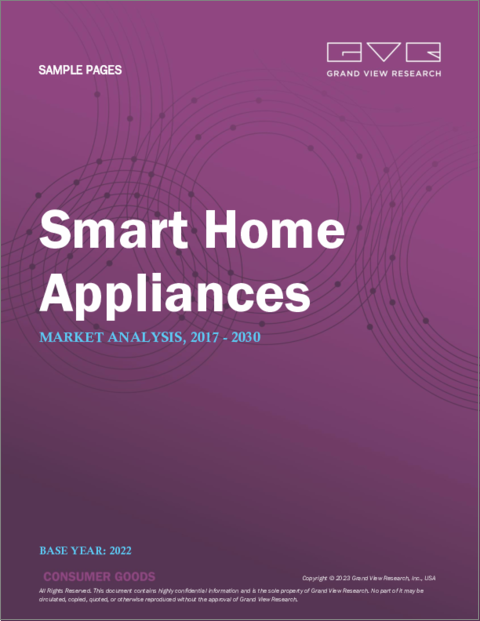|
|
市場調査レポート
商品コード
1268896
スマート家電の市場規模、シェア、動向分析レポート、製品別(スマート洗濯機、スマート空気清浄機、スマートテレビ、その他)、流通チャネル別、地域別、セグメント予測、2023~2030年Smart Home Appliances Market Size, Share & Trend Analysis Report By Product (Smart Washing Machines, Smart Air Purifiers, Smart TV, Others), By Distribution Channel, By Region, And Segment Forecasts, 2023 - 2030 |
||||||
|
● お客様のご希望に応じて、既存データの加工や未掲載情報(例:国別セグメント)の追加などの対応が可能です。 詳細はお問い合わせください。 |
|||||||
| スマート家電の市場規模、シェア、動向分析レポート、製品別(スマート洗濯機、スマート空気清浄機、スマートテレビ、その他)、流通チャネル別、地域別、セグメント予測、2023~2030年 |
|
出版日: 2023年04月27日
発行: Grand View Research
ページ情報: 英文 90 Pages
納期: 2~10営業日
|
- 全表示
- 概要
- 図表
- 目次
スマート家電の市場成長と動向:
Grand View Research, Inc.の新しいレポートによると、世界のスマート家電市場規模は2030年までに585億1,000万米ドルに達し、2023年から2030年まで9.2%のCAGRでさらに拡大すると予測されています。
市場の成長は、新興国市場と先進国市場の両方におけるスマートホームの普及拡大、ITインフラの急速な開拓と進歩、人口動態の好みの変化、温室効果ガスや有害廃棄物などの汚染排水から地球環境を保護する必要性などの要因によって大きく後押しされています。
各ブランドは、ミレニアル世代やGen-Z世代を意識した幅広い製品を提供しており、その結果、スマート家電市場には多くの機会がもたらされています。高級なスマートライトの使用から先進的なAI蛇口まで、この動向は市場の将来にとって良い兆しです。
住宅に組み込まれた技術革新は、この業界の主要な需要促進要因となっています。家電ブランドは、自動化でマルチタスクに対応し、AIを搭載した高級技術主導の家電を提供することで、自宅でカスタマイズされた体験を再現することを容易にしています。例えば、エレクトロラックスABは、製品開発および生産コストを下げるために、大規模なモジュール化プログラムを実施しています。同社の家電製品の65%近くは、低コストで製造されています。
スマート洗濯機は最大のセグメントとして浮上し、2022年には35.29%の市場シェアを占め、予測期間中はこのセグメントが優位に立つと予想されます。スマート空気清浄機セグメントは、2023年から2030年にかけて最も速いCAGR 10.2%で拡大すると予想されます。特にCOVID-19の大流行により、世界中で衛生要因への関心が高まっていることが、スマート空気清浄機セグメントの成長を後押ししています。
世界保健機関(WHO)によると、10人中9人が高レベルの汚染物質を含む汚染された空気を吸っています。屋外と屋内の大気汚染により、毎年多くの人々が屋内の大気汚染にさらされたために死亡していると述べています。
スマート家電市場は、Whirlpool Corporation、LG Electronics、BSH Hausgerate GmbH、Samsung Electronics Co. Ltd. などの老舗企業が存在することが特徴です。これらの企業は、スマート家電市場でかなりのシェアを占めており、世界中で強い存在感を示しています。スマート家電市場には、一部のスマート家電を提供し、主に地域顧客にサービスを提供する中小規模のプレーヤーも存在します。
スマート家電市場レポートハイライト
- スマート家電市場は、2023年から2030年にかけてCAGR9.2%で拡大すると予測されています。発展途上地域と先進地域の両方において、世界中でスマートホームの普及が進んでいることが、さまざまなスマート家電の需要を牽引しています。
- 2022年にはオフライン流通セグメントが63.9%の最大シェアを占めました。ミレニアル世代や若い人々の間でオンラインショッピングやスマートで接続されたデバイスの人気が高まっており、世界中でスマート家電のオンライン販売を後押ししています。
- スマート空気清浄機製品カテゴリーは、2023年から2030年の間に10.2%の最速成長率が見込まれています。健康に対する意識の高まりと先進技術の採用が進むことで、今後数年間は空気清浄機の需要が高まると考えられます。
- アジア太平洋は、世界最大のスマート家電市場であり、そのシェアは44.1%に達しています。同地域の成長は、クラウドベースのサービス導入の増加、インターネット普及率の上昇、地域住民の一人当たり所得の増加、スマートフォンの導入の急増、ライフスタイルの変化などに起因していると考えられる.
目次
第1章 調査手法と範囲
- 市場セグメンテーションと範囲
- 市場の定義
- 情報調達
- 購入したデータベース
- GVRの内部データベース
- 二二次情報と第三者の視点
- 1次調査
- 情報分析
- データ分析モデル
- 市場の形成とデータの視覚化
- データの検証と公開
第2章 エグゼクティブサマリー
- 市場の見通し
- 製品の展望
- 配布の見通し
- 地域別の見通し
第3章 スマート家電市場の変数、動向、範囲
- 市場系統の見通し
- 業界のバリューチェーン分析
- サプライヤーの見通し
- ものづくりと技術の動向
- 利益率分析
- 市場力学
- 市場促進要因の分析
- 市場抑制要因分析
- 業界の課題
- 業界のチャンス
- 業界分析ツール
- 業界分析- ポーターズ
- 市場参入戦略
第4章 消費者行動分析
- 人口統計分析
- 消費者の動向と好み
- 購入決定に影響を与える要因
- 消費者向け製品の採用
- 所見と推奨事項
第5章 スマート家電市場:製品推定・動向分析
- 製品変動分析と市場シェア、2022年と2030年
- スマート洗濯機
- スマート空気清浄機
- スマートテレビ
- その他
第6章 スマート家電市場:流通チャネルの推定・動向分析
- 流通チャネルの変動分析と市場シェア、2022年と2030年
- オンライン
- オフライン
第7章 スマート家電市場:地域推定・動向分析
- 地域変動分析と市場シェア、2022年と2030年
- 北米
- 製品別、2017~2030年
- 流通チャネル別、2017~2030年
- 米国
- 欧州
- 製品別、2017~2030年
- 流通チャネル別、2017~2030年
- 英国
- アジア太平洋地域
- 製品別、2017~2030年
- 流通チャネル別、2017~2030年
- 中国
- インド
- 日本
- 中南米
- 製品別、2017~2030年
- 流通チャネル別、2017~2030年
- ブラジル
- 中東とアフリカ
- 製品別、2017~2030年
- 流通チャネル別、2017~2030年
- 南アフリカ
第8章 スマート家電市場:競合情勢
- 主要市場参入企業別最近の動向と影響分析
- 会社の分類
- 参加者の概要
- 財務実績
- 製品のベンチマーク
- 企業の市場シェア分析、2022年(%)
- 企業ヒートマップ分析
- 戦略マッピング
- このセクションで分析される主要企業のリストには次のものが含まれます
- Whirlpool Corp.
- LG Electronics
- Haier Group
- Samsung Electronics Co. Ltd.
- Panasonic Corp.
- BSH Hausgerate GmbH
- Electrolux AB
- Koninklijke Philips NV
- GE Appliances
- Xiaomi Corp.
List of Tables
- 1. Smart home appliance market estimates & forecast, by product (USD Billion)
- 2. Smart home appliance market estimates & forecast, by distribution channel (USD Billion)
- 3. U.S. macro-economic outlay
- 4. U.K. macro-economic outlay
- 5. China macro-economic outlay
- 6. India macro-economic outlay
- 7. Japan macro-economic outlay
- 8. Brazil macro-economic outlay
- 9. South Africa macro-economic outlay
- 10. Recent developments & impact analysis, by key market participants
List of Figures
- 1. Smart home appliances market segmentation
- 2. Information procurement
- 3. Primary research pattern
- 4. Primary research approaches
- 5. Primary research process
- 6. Market Snapshot
- 7. Segment Snapshot
- 8. Competitive Landscape Snapshot
- 9. Smart home appliance market - Industry value chain analysis
- 10. Smart home appliance market dynamics
- 11. Smart home appliance market: PORTER's analysis
- 12. Smart home appliance market, by product: Key takeaways
- 13. Smart home appliance market, by product: Market share, 2022 & 2030
- 14. Smart home appliance market estimates & forecasts, by smart washing machines, 2017 - 2030 (USD Billion)
- 15. Smart home appliance market estimates & forecasts, by smart air purifiers, 2017 - 2030 (USD Billion)
- 16. Smart home appliance market estimates & forecasts, by smart TV, 2017 - 2030 (USD Billion)
- 17. Smart home appliance market estimates & forecasts, by others, 2017 - 2030 (USD Billion)
- 18. Smart home appliance market, by distribution channel: Key takeaways
- 19. Smart home appliance market, by distribution channel: Market share, 2022 & 2030
- 20. Smart home appliance market revenue, by region, 2022 & 2030 (USD Billion)
- 21. Regional marketplace: Key takeaways
- 22. Regional marketplace: Key takeaways
- 23. North America smart home appliance market estimates & forecast, 2017 - 2030 (USD Billion)
- 24. U.S. smart home appliance market estimates & forecast, 2017 - 2030 (USD Billion)
- 25. Europe smart home appliance market estimates & forecasts, 2017 - 2030 (USD Billion)
- 26. U.K. smart home appliance market estimates & forecasts, 2017 - 2030 (USD Billion)
- 27. Asia Pacific smart home appliance market estimates & forecast, 2017 - 2030 (USD Billion)
- 28. China smart home appliance market estimates & forecast, 2017 - 2030 (USD Billion)
- 29. India smart home appliance market estimates & forecast, 2017 - 2030 (USD Billion)
- 30. Japan smart home appliance market estimates & forecast, 2017 - 2030 (USD Billion)
- 31. Central & South America Smart home appliance market estimates & forecast, 2017 - 2030 (USD Billion)
- 32. Brazil Smart home appliance market estimates & forecast, 2017 - 2030 (USD Billion)
- 33. Middle East & Africa Smart home appliance market estimates & forecast, 2017 - 2030 (USD Billion)
- 34. South Africa Smart home appliance market estimates & forecast, 2017 - 2030 (USD Billion)
- 35. Key company categorization
- 36. Company market share analysis, 2022 (Value % Share)
Smart Home Appliances Market Growth & Trends:
The global smart home appliances market size is expected to reach USD 58.51 billion by 2030 and will expand further at a CAGR of 9.2% from 2023 to 2030, according to a new report by Grand View Research, Inc. The market growth is largely driven by factors such as growing penetration of smart homes, both in developing and developed regions, rapid developments and advancements in the IT infrastructure, shifting demographic preferences, and the need to safeguard the global environment from polluting effluents, such as greenhouse gases and toxic wastes.
Brands are offering a wide range of products keeping in mind the millennial and Gen-Z generations, resulting in a plethora of opportunities in the smart home appliances market. From using premium smart lights to advanced AI-faucets, the trend bodes well for the future of the market.
Technological innovations incorporated into homes have been key demand driving factor for this industry. Home appliance brands are making it easier to recreate a customized experience at home by offering luxury tech-driven home appliances that are designed to multi-task with automation and are AI-driven. For instance, Electrolux AB has an extensive modularization program that lowers product development and production costs. Nearly 65% of the company's home appliances are manufactured at a low cost.
Smart washing machines emerged as the largest segment and accounted for a market share of 35.29% in 2022, and this segment is expected to be dominant during the forecast period. The smart air purifiers segment is expected to expand at the fastest CAGR of 10.2% from 2023 to 2030. Increased attention to the hygiene factor across the globe, especially because of the COVID-19 pandemic, is fueling the growth of the smart air purifiers segment.
According to the World Health Organization (WHO), 9 out of 10 people breathe contaminated air containing a high level of pollutants. It states that outdoor and indoor air pollution lead to around 7 million premature deaths every year, out of which 3.8 million people die because of exposure to indoor air pollution.
The smart home appliances market is characterized by the presence of several well-established players, such as Whirlpool Corporation; LG Electronics; BSH Hausgerate GmbH; and Samsung Electronics Co. Ltd. These players account for considerable shares in the smart home appliances market and have a strong presence across the globe. The smart home appliances market also consists of small to mid-sized players who offer a selected range of smart home appliances and mostly serve regional customers.
Smart Home Appliances Market Report Highlights:
- The smart home appliances market is expected to expand at a compound annual growth rate (CAGR) of 9.2% from 2023 to 2030. The growing penetration of smart homes, both in developing and developed regions, across the globe is driving the demand for various smart home appliances.
- The offline distribution segment held the largest share of 63.9% in 2022.The growing popularity of online shopping and smart and connected devices among millennials as well as the young population will boost the online sale of smart home appliances worldwide.
- Smart air purifiers product category is expected to grow at the fastest rate of 10.2% between 2023 and 2030. The increasing consciousness about health and increasing adoption of advanced technologies will fuel the demand for air purifiers in the coming years.
- Asia Pacific was the largest smart home appliances market globally with a share of 44.1%. The growth of the region can be attributed to the growing implementation of cloud-based services, increasing internet penetration, rising per capita income of the regional population, escalating adoption of smartphones and changing lifestyles.
Table of Contents
Chapter 1. Methodology and Scope
- 1.1. Market Segmentation & Scope
- 1.2. Market Definition
- 1.3. Information Procurement
- 1.3.1. Purchased Database
- 1.3.2. GVR's Internal Database
- 1.3.3. Secondary Sources & Third - Party Perspectives
- 1.3.4. Primary Research
- 1.4. Information Analysis
- 1.4.1. Data Analysis Models
- 1.5. Market Formulation & Data Visualization
- 1.6. Data Validation & Publishing
Chapter 2. Executive Summary
- 2.1. Market Outlook
- 2.2. Product Outlook
- 2.3. Distribution Outlook
- 2.4. Regional Outlook
Chapter 3. Smart Home Appliances Market Variables, Trends & Scope
- 3.1. Market Lineage Outlook
- 3.2. Industry Value Chain Analysis
- 3.2.1. Suppliers Outlook
- 3.2.2. Manufacturing and Technology Trends
- 3.2.3. Profit Margin Analysis
- 3.3. Market Dynamics
- 3.3.1. Market Driver Analysis
- 3.3.2. Market Restraint Analysis
- 3.3.3. Industry Challenges
- 3.3.4. Industry Opportunities
- 3.4. Industry Analysis Tools
- 3.4.1. Industry Analysis - Porter's
- 3.4.1.1. Supplier Power
- 3.4.1.2. Buyer Power
- 3.4.1.3. Substitution Threat
- 3.4.1.4. Threat from New Entrant
- 3.4.1.5. Competitive Rivalry
- 3.4.1. Industry Analysis - Porter's
- 3.5. Market Entry Strategies
Chapter 4. Consumer Behavior Analysis
- 4.1. Demographic Analysis
- 4.2. Consumer Trends and Preferences
- 4.3. Factors Affecting Buying Decision
- 4.4. Consumer Product Adoption
- 4.5. Observations & Recommendations
Chapter 5. Smart Home Appliances Market: Product Estimates & Trend Analysis
- 5.1. Product Movement Analysis & Market Share, 2022 & 2030
- 5.2. Smart Washing Machines
- 5.2.1. Smart washing machines market estimates and forecast 2017 - 2030 (USD Billion)
- 5.3. Smart Air Purifiers
- 5.3.1. Smart air purifiers market estimates and forecast 2017 - 2030 (USD Billion)
- 5.4. Smart TV
- 5.4.1. Smart TV market estimates and forecast 2017 - 2030 (USD Billion)
- 5.5. Others
- 5.5.1. Others market estimates and forecast 2017 - 2030 (USD Billion)
Chapter 6. Smart Home Appliances Market: Distribution Channel Estimates & Trend Analysis
- 6.1. Distribution Channel Movement Analysis & Market Share, 2022 & 2030
- 6.2. Online
- 6.2.1. Market estimates and forecast through online distribution channel, 2017 - 2030 (USD Billion)
- 6.3. Offline
- 6.3.1. Market estimates and forecast through offline distribution channel, 2017 - 2030 (USD Billion)
Chapter 7. Smart home appliances Market: Regional Estimates & Trend Analysis
- 7.1. Regional Movement Analysis & Market Share, 2022 & 2030
- 7.2. North America
- 7.2.1. Market estimates and forecast, 2017 - 2030 (USD Billion)
- 7.2.2. Market estimates and forecast, by product, 2017 - 2030 (USD Billion)
- 7.2.3. Market estimates and forecast by distribution channel, 2017 - 2030 (USD Billion)
- 7.2.4. U.S.
- 7.2.4.1. Market estimates and forecast, 2017 - 2030 (USD Billion)
- 7.2.4.2. Market estimates and forecast, by product, 2017 - 2030 (USD Billion)
- 7.2.4.3. Market estimates and forecast by distribution channel, 2017 - 2030 (USD Billion)
- 7.3. Europe
- 7.3.1. Market estimates and forecast, 2017 - 2030 (USD Billion)
- 7.3.2. Market estimates and forecast, by product, 2017 - 2030 (USD Billion)
- 7.3.3. Market estimates and forecast by distribution channel, 2017 - 2030 (USD Billion)
- 7.3.4. U.K.
- 7.3.4.1. Market estimates and forecast, 2017 - 2030 (USD Billion)
- 7.3.4.2. Market estimates and forecast, by product, 2017 - 2030 (USD Billion)
- 7.3.4.3. Market estimates and forecast by distribution channel, 2017 - 2030 (USD Billion)
- 7.4. Asia Pacific
- 7.4.1. Market estimates and forecast, 2017 - 2030 (USD Billion)
- 7.4.2. Market estimates and forecast, by product, 2017 - 2030 (USD Billion)
- 7.4.3. Market estimates and forecast by distribution channel, 2017 - 2030 (USD Billion)
- 7.4.4. China
- 7.4.4.1. Market estimates and forecast, 2017 - 2030 (USD Billion)
- 7.4.4.2. Market estimates and forecast, by product, 2017 - 2030 (USD Billion)
- 7.4.4.3. Market estimates and forecast by distribution channel, 2017 - 2030 (USD Billion)
- 7.4.5. India
- 7.4.5.1. Market estimates and forecast, 2017 - 2030 (USD Billion)
- 7.4.5.2. Market estimates and forecast, by product, 2017 - 2030 (USD Billion)
- 7.4.5.3. Market estimates and forecast by distribution channel, 2017 - 2030 (USD Billion)
- 7.4.6. Japan
- 7.4.6.1. Market estimates and forecast, 2017 - 2030 (USD Billion)
- 7.4.6.2. Market estimates and forecast, by product, 2017 - 2030 (USD Billion)
- 7.4.6.3. Market estimates and forecast by distribution channel, 2017 - 2030 (USD Billion)
- 7.5. Central and South America
- 7.5.1. Market estimates and forecast, 2017 - 2030 (USD Billion)
- 7.5.2. Market estimates and forecast, by product, 2017 - 2030 (USD Billion)
- 7.5.3. Market estimates and forecast by distribution channel, 2017 - 2030 (USD Billion)
- 7.5.4. Brazil
- 7.5.4.1. Market estimates and forecast, 2017 - 2030 (USD Billion)
- 7.5.4.2. Market estimates and forecast, by product, 2017 - 2030 (USD Billion)
- 7.5.4.3. Market estimates and forecast by distribution channel, 2017 - 2030 (USD Billion)
- 7.6. Middle East and Africa
- 7.6.1. Market estimates and forecast, 2017 - 2030 (USD Billion)
- 7.6.2. Market estimates and forecast, by product, 2017 - 2030 (USD Billion)
- 7.6.3. Market estimates and forecast by distribution channel, 2017 - 2030 (USD Billion)
- 7.6.4. South Africa
- 7.6.4.1. Market estimates and forecast, 2017 - 2030 (USD Billion)
- 7.6.4.2. Market estimates and forecast, by product, 2017 - 2030 (USD Billion)
- 7.6.4.3. Market estimates and forecast by distribution channel, 2017 - 2030 (USD Billion)
Chapter 8. Smart Home Appliance Market: Competitive Landscape
- 8.1. Recent developments & impact analysis, by key market participants
- 8.2. Company Categorization
- 8.3. Participant's Overview
- 8.4. Financial Performance
- 8.5. Product Benchmarking
- 8.6. Company Market Share Analysis, 2022 (%)
- 8.7. Company Heat Map Analysis
- 8.8. Strategy Mapping
- 8.9. List of key companies analyzed in this section includes:
- 8.9.1. Whirlpool Corp.
- 8.9.2. LG Electronics
- 8.9.3. Haier Group
- 8.9.4. Samsung Electronics Co. Ltd.
- 8.9.5. Panasonic Corp.
- 8.9.6. BSH Hausgerate GmbH
- 8.9.7. Electrolux AB
- 8.9.8. Koninklijke Philips N.V
- 8.9.9. GE Appliances
- 8.9.10. Xiaomi Corp.




